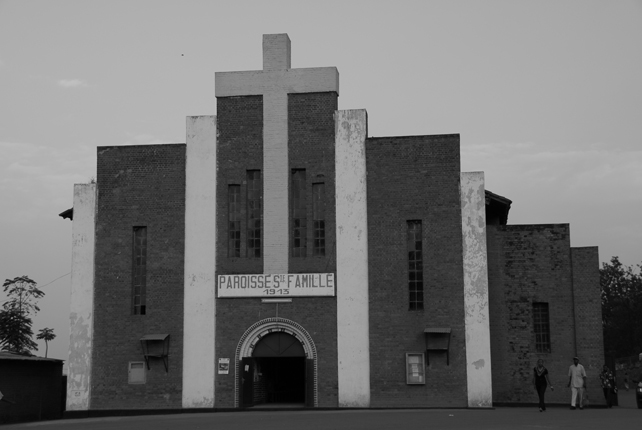
|
The St Famille Church is located in the Town of Kigali. Click on the image for a slideshow of photographs. All photographs © 2002-2008 Jens Meierhenrich. |

|
The St Famille Church is located in the Town of Kigali. Click on the image for a slideshow of photographs. All photographs © 2002-2008 Jens Meierhenrich. |
“The doors of the church were open to everybody. They were closed at night to stop anyone from trying to escape.” So recalled a survivor of the months-long ordeal that began on April 8 and ended around June 30, 1994 at Kigali’s austere Sainte Famille Church. The long torment at Sainte Famille, including multiple massacres and rapes, throws into sharp relief the high level of organization, efficiency, intimacy, and modernity behind Rwanda’s twentieth-century atrocity, as well as the gender-specific targeting of men and boys that oftentimes occurred.
A witness who spoke to the non-governmental organization African Rights, which chronicled the unfolding of Rwanda’s genocide in Death, Despair, and Defiance, said, “15 April was an unhappy day for the Tutsi refugees. At about 9:00 a.m., many well-armed militias invaded St. Famille. They came from several quarters of Kigali city including mine. I recognized the faces of several militiamen from my cellule (a cellule, French for “cell,” was an administrative unit, amounting, in essence, to a neighborhood). They told all the refugees, both Hutus and Tutsis, to return to the church and go inside. They had lists of targeted Tutsis. Each pew was guarded by at least ten assassins. The calling out of names did not take long to start. Many Tutsi men and boys were called. They made a long chain, joined together by their shirts. It was like the slave trade. They took the Tutsis out in several turns. At each exit we heard gun fire at the bottom of the church. The calling out continued until 4:00 p.m. [...] Before they left they told Abbé Wenceslas (Munyeshyaka, the Catholic priest in charge of Sainte Famille) to separate the Tutsis from the Hutus. They also told him that next time it would be the women’s turn. Wenceslas told them that the women were not a problem as they did not have an ethnicity. He said the bad ones were the men.”
Father Munyeshyaka, who was reportedly seen carrying a pistol and wearing a flak jacket, was charged by the International Criminal Tribunal for Rwanda, or ICTR, with genocide, rape as a crime against humanity, extermination as a crime against humanity, and murder as a crime against humanity. However, on November 20, 2007, that Tribunal’s Prosecutor—in keeping with the ICTR’s so-called completion strategy—ordered that Munyeshyaka be tried in France instead. Back in Rwanda, Sainte Famille is an active parish that today even supports a driving school. On the church façade there is no indication that genocide ever happened here.
Copyright © 2010 Jens Meierhenrich. All rights reserved.